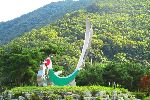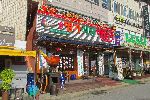Ibike Korea People-to-People Program
 Photo essay: Saejae
Trail:
Photo essay: Saejae
Trail:
Chungju to
Ihwalyeong Pass
Chungju to Ihwalyeong Pass (50mi, 80km) Beautiful valleys separated by a mountain pass.
Points of Interest: Spa town, river valley, forests, continental divide.

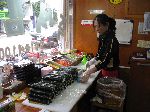
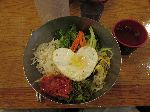 There
are a couple of chains of 'gimbap' restaurants. The both use yellow and
orange in there color schemes and they are both open early for breakfast.
Besides gimbap (similar to sushi) and being quick, the restaurants have
extensive menus including omelets, cutlets, noodle soups, mandu (dumplings),
fried rice, etc. Something for almost every pallet. They were always
a good choice for breakfast when we could find one. Checkout the shape of the
egg in the bibimbap!
There
are a couple of chains of 'gimbap' restaurants. The both use yellow and
orange in there color schemes and they are both open early for breakfast.
Besides gimbap (similar to sushi) and being quick, the restaurants have
extensive menus including omelets, cutlets, noodle soups, mandu (dumplings),
fried rice, etc. Something for almost every pallet. They were always
a good choice for breakfast when we could find one. Checkout the shape of the
egg in the bibimbap!

Korea is known as the land of the morning calm -- in the fall it can also come with a morning mist (left, Seoluncheon (river).
This farmer (right) has harvested his perilla (wild sesame) and is spreading it along the guard rail of a bridge to dry. The leaves are served fresh and used as a wrap for fried meat. The seeds are used dried or pressed for oil.

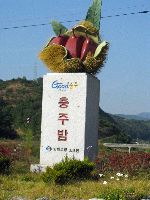
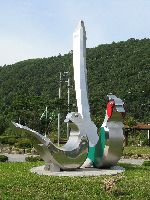 Many
districts have symbols. To the left are apples. Although apple orchard seem
fairly common in other parts of the country I am assuming this is the
self-proclaimed apple
capital of Korea and with that comes an apple festival.
Many
districts have symbols. To the left are apples. Although apple orchard seem
fairly common in other parts of the country I am assuming this is the
self-proclaimed apple
capital of Korea and with that comes an apple festival.Another sculpture seemed to be a pheasant. Pheasant is a culinary specialty in the area. There are dozens of pheasant restaurants in and around Suanbo so either the peasant population is endangers or there is also peasant farming in the area.
The third in this
series is a chestnut, which was logical because a lot of chestnuts had fallen on
the road (in October), but again, they can be found throughout the country.
.
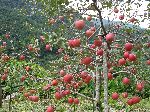
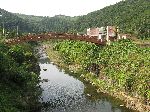
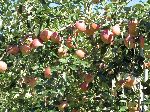 Sure enough,
up the valley and up in the hills, there were
health apple orchards in the area. They produce more apples on one branch
of a tree than I can get off of a whole tree four times as large. The
dearth of leaves on the tree is interesting.
Sure enough,
up the valley and up in the hills, there were
health apple orchards in the area. They produce more apples on one branch
of a tree than I can get off of a whole tree four times as large. The
dearth of leaves on the tree is interesting.
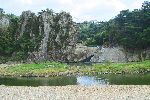
[2015 update: Each year there are new improvement to this trail: The signage is better, links are added to get users from one existing section of farm road to the next and the route has been diverted from the main highway to roads further a field.
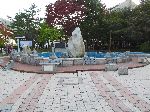
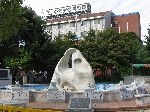 Midway into the mountains
is Suambo, or generally referred to as the "spa town." The streets have a
small town feel, but ringing the very modest town center is a disproportionate number
of high-rise hotels. At least in early October the town isn't full of
people so it was hard to get a sense of the spa part of the local economy.
Midway into the mountains
is Suambo, or generally referred to as the "spa town." The streets have a
small town feel, but ringing the very modest town center is a disproportionate number
of high-rise hotels. At least in early October the town isn't full of
people so it was hard to get a sense of the spa part of the local economy.
By the numbers, the water originates 250m underground, it flows at a rate of 4800 tons a day and it is 53oC. It is high in copper, fluoride and silic acid. The ph is in the range of 8.4-8.7. It is said to be effective for neuralgia, arthritis, rheumatism, stomach disorders, female diseases, dermatitis, and prevention of cavities.
If you want to partake head to one of the "jjimjilbang", a Korean spa. In Suambo they are mostly at the bigger hotel. The facilities are generally separated by gender. There are lockers, users disrobe completely and take shows before entering the baths.
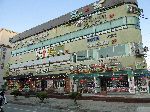
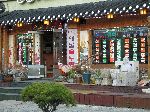
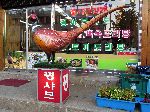
If you want to eat pheasant in Suambo you are in luck. It is the local specialty. There can be four restaurants a block all serving pheasant -- you'll know from the pheasant statues out front.
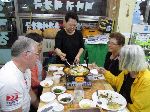
 For
what ever reason this group didn't want pheasant. They did want duck, but
the kitchen was out of duck, so they settled for chicken.
For
what ever reason this group didn't want pheasant. They did want duck, but
the kitchen was out of duck, so they settled for chicken.Suambo is expensive by small-town-Korea standards. It was nice to see that one hotel offered a room discount of 40% to bicyclists. This brought the rate down to near what you might expect to pay at a small hotels in other towns.
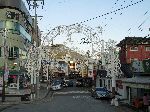
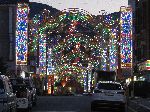
Street by day and night in Suambo. It is festive without a festival.
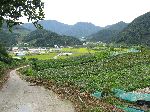
 As
we start up hills, burial sites are again a more common site.
As
we start up hills, burial sites are again a more common site.On the top of the hills and ridges in this area are scattered ruminants of fortresses and fortress walls. The fortresses are believed to have been built during the Three Kingdoms Era (B.C. 57 - A.D. 668) by Goguryeo Kingdom. Since Chungju and the South Han River was the border area between the Silla and Goguryeo, these mountains had strategic importance for the Goguryeo defending their southern border.
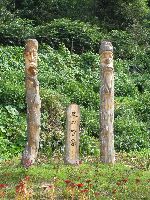
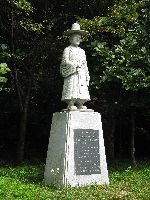 up against the trees, a statue of a traditional young
scholar
stood vigil. (Note 2015: He seems to have been moved to widen the road and
better accommodate bicycles.)
up against the trees, a statue of a traditional young
scholar
stood vigil. (Note 2015: He seems to have been moved to widen the road and
better accommodate bicycles.)The scholar is from the Joseon Dynasty. At that time he would have had to walk the trail over the pass from Yongnam (southeast of the Mungyeong Saejae pass) to get to Hanyang (Seoul's name at the time), to take the scholastic (civil service) test. Students who scored high would be picked by the kings to work as a government employee. The statue shows how the applicants looked on their way to Hanynag for the test. [The statue disappeared about 2014, presumable to accommodate the widening of the road to allow for wider shoulders / bike lanes.]

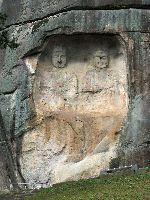
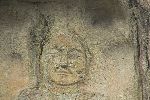 Along
the highway there are a couple of large Buddha carved into stone cliff,
Yichebul
(이체불),
Amida Buddha
and Sakyamuni
Buddha.
These cultural treasures are from the Three
Kingdoms and Unified Silla Goryeo
Dynasty. The name seems to translate as "remember the sedentary light". The two seated Buddha's are posed very formally.
There are smaller Buddha carved in the halos of light around their faces. This
form of two Buddha carved side-by-side, in a rock face is rare. They are
presumed to be influenced by the Buddha of the Eastern Paradise and Sakyamuni
Along
the highway there are a couple of large Buddha carved into stone cliff,
Yichebul
(이체불),
Amida Buddha
and Sakyamuni
Buddha.
These cultural treasures are from the Three
Kingdoms and Unified Silla Goryeo
Dynasty. The name seems to translate as "remember the sedentary light". The two seated Buddha's are posed very formally.
There are smaller Buddha carved in the halos of light around their faces. This
form of two Buddha carved side-by-side, in a rock face is rare. They are
presumed to be influenced by the Buddha of the Eastern Paradise and Sakyamuni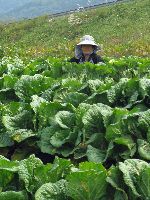 Buddha fables in the Lotus Sutra. The carved area is 12m high.
Buddha fables in the Lotus Sutra. The carved area is 12m high.Around another curve in the road a woman was tending her cabbage, one-by-one.
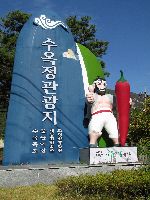
On the far outskirts of Yeonpung there are some yeogwans, but no convenient restaurants. In Yeonpung there are several restaurants but only one sketchy hotel that is not always attended..
Turning west at Yeonpung will put you on the
Ocheon Trail,
![]()
which connects the Saejae Trail to the Guemgang Trail at Sejong, via Yangpyeong
and Cheongju. In this direction you won't find the co-location of a hotel and
restaurant until Goesan-si.
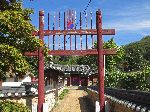
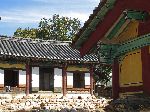
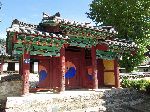 The
point of interest in Yeonpung is the Yeonpung Hyanggyo (government school),
founded in 1515. Hyanggyos were a local educational institution from Goryeo
(910-1392) down through the Joseon Dynasty (1392-1910). They served primarily
the children of the yangban, or ruling elite upper-class. Education was
oriented toward the gwageo, or national civil service examinations. They
competed with the privately run seowan and seodang. This Hyanggyo is
connected with a Confucian shrine at the rear. The complex has, from front to
back, a Hongsalmun (one-pillar gate) (far left), Whaesammum (public door)
(left), Myeongnyundang (lecture hall) (right) and behind this two dormitories
and the Daeseongjeon (shrine). In 1894, the educational system was reformed
and the Confucian schools gradually closed. Conducting semi-annual memorial
rites at the shrine has continued to this day.
The
point of interest in Yeonpung is the Yeonpung Hyanggyo (government school),
founded in 1515. Hyanggyos were a local educational institution from Goryeo
(910-1392) down through the Joseon Dynasty (1392-1910). They served primarily
the children of the yangban, or ruling elite upper-class. Education was
oriented toward the gwageo, or national civil service examinations. They
competed with the privately run seowan and seodang. This Hyanggyo is
connected with a Confucian shrine at the rear. The complex has, from front to
back, a Hongsalmun (one-pillar gate) (far left), Whaesammum (public door)
(left), Myeongnyundang (lecture hall) (right) and behind this two dormitories
and the Daeseongjeon (shrine). In 1894, the educational system was reformed
and the Confucian schools gradually closed. Conducting semi-annual memorial
rites at the shrine has continued to this day.
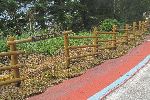 At Yeonpung the
Saejae Trail passes
under the new Hwy 3 Expressway and heads up towards Ihwalyeong Pass. In
2011 bike lanes and several view points were added on both sides of the road up
to the pass. On the corners and sharp curves the bike lanes are identified
with red asphalt.
At Yeonpung the
Saejae Trail passes
under the new Hwy 3 Expressway and heads up towards Ihwalyeong Pass. In
2011 bike lanes and several view points were added on both sides of the road up
to the pass. On the corners and sharp curves the bike lanes are identified
with red asphalt.
A favorite feature is the wildlife pass-through (right). Note the first span in the photo has no rails across it, and the sign above it instructs
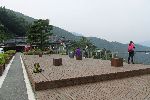
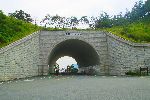 From
a ragged gravel parking lot, Ihwalyeong Pass has been turned into fancy rest
stop and view point.
From
a ragged gravel parking lot, Ihwalyeong Pass has been turned into fancy rest
stop and view point.
The ridge over the highway is entirely artificial, it preserves access along the ridge, presumably for hikers or wildlife.
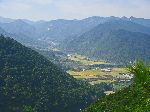
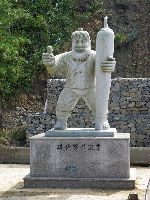 At
Ihwalyeong Pass, elevation 529m (~1750 ft), there used to be that a sculpture with the big kochu
(chili pepper) greeting all visitors, but he has disappeared with the
renovations.
At
Ihwalyeong Pass, elevation 529m (~1750 ft), there used to be that a sculpture with the big kochu
(chili pepper) greeting all visitors, but he has disappeared with the
renovations.
Descending the east side of the pass is a breeze, but at the bottom, if you aren't diligent, before you know it, you will fly on to the new Hwy 3, without any easy escape. The solution, though it is not signed (at least in 2012), is to turn left and pass under Hwy 3 just before the stealth on-ramp. Hopefully by the time the National Network is fully built out better signage will appear.
Mungyeong Saejae Provincial Park (the now forbidden route)


As we were turning back from the gate -- at the top -- we met a group of local visitor. Our disappointed looks must have raised questions in them. If we had argued the policy with the official, their position probably would have become more entrenched. But our new friends (left) didn't think our situation was fair, and they could discuss the matter Korea to Korea. Bless them. They negotiated an arrangement where we could pass, but we were to walk our bikes through the park. It sure beat dropping back down the mountain and going through another pass. As it is the route through the park is more than sufficiently interesting and beautiful that no one didn't mind spending a little more time at it -- walking.

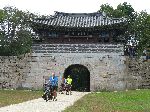
 Joryeong-gwan, 3rd gate:
This was a major transportation route dating back to the Three Kingdoms period
(18 BC-935 AD). The gate became strategically significant during the Goryeo
Kingdom (918-1392).
Joryeong-gwan, 3rd gate:
This was a major transportation route dating back to the Three Kingdoms period
(18 BC-935 AD). The gate became strategically significant during the Goryeo
Kingdom (918-1392).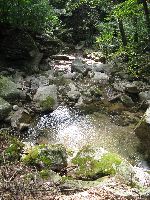
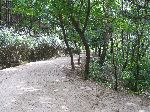


It is 4km of wooded road and streams to the next gate. Walking provided time to photograph and relax, listen to the natural sounds of wind and
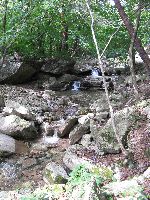
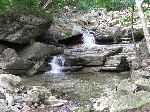
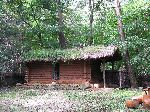
water, too absorb the pure air, and enjoy the calm energy of the forest and mountains. There was almost on one else on the road.
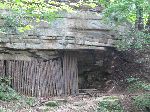
Once upon a time, a man was passing by the cave when he was caught by a shower. When he walked in the cave to take a shelter he saw a woman had already taken shelter in the cave. The two passers-by developed an instant love in the cave and went their ways when the rain stopped.
Later, the woman conceived a boy from the encounter. After 10 years the son was ridiculed by his friends for having no father. The mother was obliged to tell her son exactly what happened and what his father looked like.
The son decided to take a walking tour of the country to locate his father. When the son was walking an trail in a deep gorge, he was caught in a shower and entered a road side tavern to spend the night. The boy doubled up his room with a middle-aged scholar who said to himself , "Oh, this rain feels like a saejaewoo," meaning a rain falling in Saejae. The son felt something special about "saejaewoo" and asked what he meant by "saejaewoo." At the invitation, the scholar told the son of the affair at the cave. The father and son went together to the boy's mother to live as a happy family ever after.
Still, people believe if a boy and a girl enter this cave together, they will develop a deep and long-lasting love.

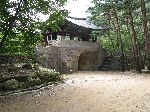
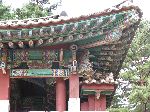 Jogog-gwan, 2nd gate.
Possibly originally constructed in the Three Kingdoms period (18 BC - 935 AD).
Reconstructed by Chungwon civilian, Shin Chungwon, to stop the Japanese in 1592.
Fortified by King Sukjong (r 1674-1720) in 1708. The last restoration was in
1976.
Jogog-gwan, 2nd gate.
Possibly originally constructed in the Three Kingdoms period (18 BC - 935 AD).
Reconstructed by Chungwon civilian, Shin Chungwon, to stop the Japanese in 1592.
Fortified by King Sukjong (r 1674-1720) in 1708. The last restoration was in
1976.

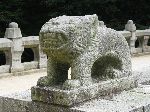 Just
south of the gate is a large stream, that now has an ornate and elegant bridge.
If this wasn't the case in 1592, the stream would have provided an added
obstacle for an invading army trying to getting past the gate.
Just
south of the gate is a large stream, that now has an ornate and elegant bridge.
If this wasn't the case in 1592, the stream would have provided an added
obstacle for an invading army trying to getting past the gate.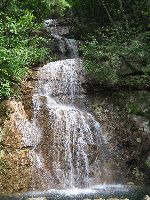
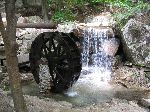 With
another five kilometers to the next gate we had more time to enjoy the natural
qualities of the environment.
With
another five kilometers to the next gate we had more time to enjoy the natural
qualities of the environment.Below the second gate we were more walkers on the road, but minutes could pass without see another soul. For a weekday it seem like a significant number of people in the park, but it was far from crowded.
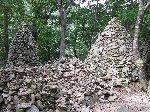
The belief is passers-by should lay a stone on the pagoda. It is said that scholars who laid stones here passed the government tests, weak persons who laid stones here became strong, merchants got prosperous and women who had not been able to conceive were able to conceive boys.
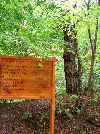
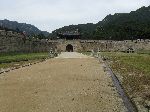
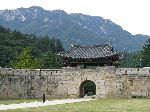 Juhul-gwan, the 1st gate. It was fortified by King Sukjong (r 1674-1720) in
1708. Unfortunately, this was more than 110 years after the Japanese had
already stormed through on their way to Seoul.
Juhul-gwan, the 1st gate. It was fortified by King Sukjong (r 1674-1720) in
1708. Unfortunately, this was more than 110 years after the Japanese had
already stormed through on their way to Seoul.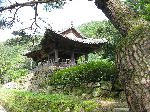
It was only between the parking lot and Juhul-gwan that we encounter a lot of people. Ironically, in this the most heavily used part of the park, there was a pretty steady stream of motor vehicles on the roadway, chasing the pedestrians off to the bushes or at least the very sides of the road. Theoretically, the road was closed to traffic and everyone was suppose to park in large parking lots further down. Somehow a lot of vehicles were getting exemptions, but there wasn't a clear pattern.
Return to allowed route past Mungyeong Saejae Provincial Park.
 Please
contact us if you would like to be added to
Ibike's mailing list or have questions, comments, corrections or criticism. (Also, please let us know how you learned about us and
found this site.) Privacy policy.
Please
contact us if you would like to be added to
Ibike's mailing list or have questions, comments, corrections or criticism. (Also, please let us know how you learned about us and
found this site.) Privacy policy.
![]() IBF Homepage
IBF Homepage ![]() Ibike Programs
Ibike Programs
![]() Ibike Schedule
Ibike Schedule
![]() Search
Search
